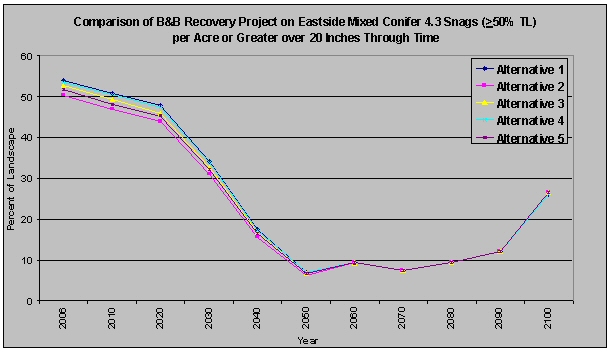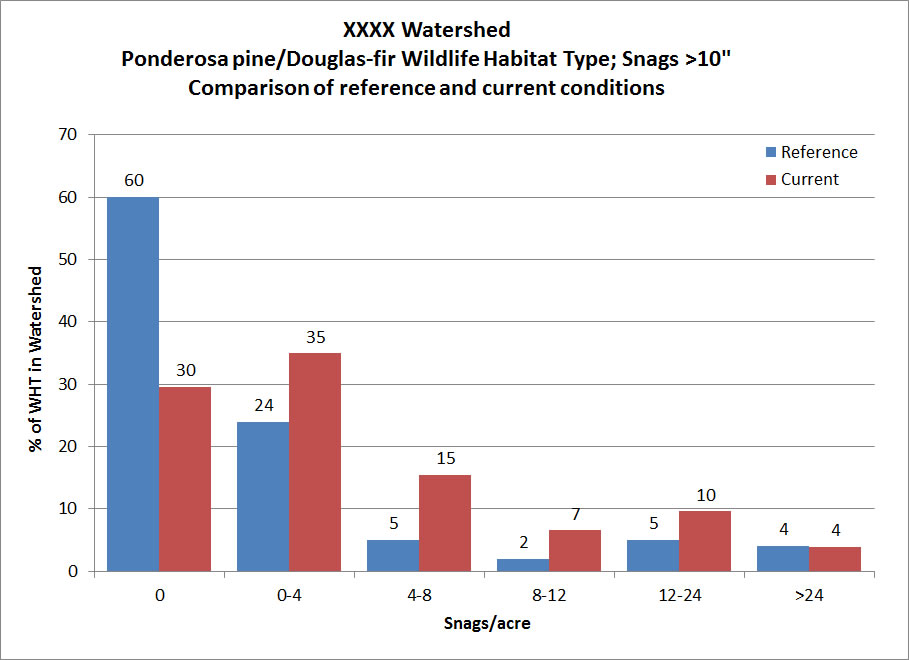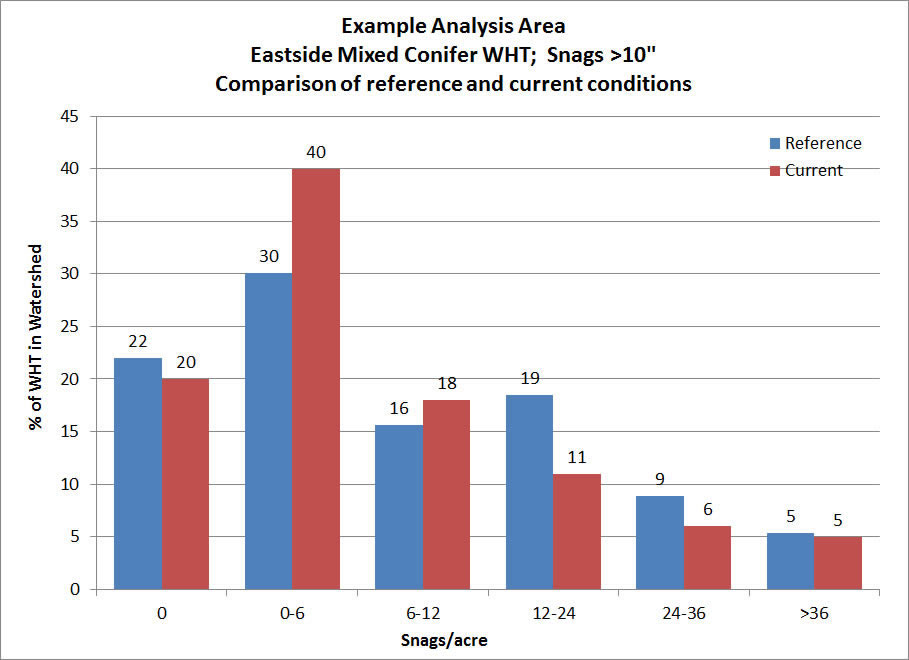DecAID Implementation: Post-Disturbance Salvage Sales
Distribution Analysis for Salvage Projects
Objective of a Distribution Analysis
A distribution analysis allows you to compare current condition to reference conditions of amounts and distribution of dead wood across the landscape, as represented by the vegetation inventory distribution histograms in DecAID. The closer the current conditions are to reference conditions the higher the likelihood that adequate habitat is being provided for dead wood associated species and processes. This analysis can be conducted for snags or for down wood.
The Distribution Analysis process for salvage sales is similar to the process for green sales, but with a few important extra steps.
First Step - Determine the Analysis Area
Project areas are usually delineated to encompass an area containing stands to be treated. These areas are usually too small to adequately analyze the impacts of the project on dead wood levels across the landscape. The inventory data in the DecAID Advisor are appropriately used to assess dead wood at the landscape level, not at the project or stand scale.
Snag and down wood levels in the analysis area can be compared against the information from inventory data contained in DecAID only if the area is large enough to allow such a comparison. The analysis area should be large enough to represent the variation in snag habitat and distribution from which the inventory data were collected. If this is not possible, a comparison between the project area and the inventory data is not appropriate.
Salvage sales after stand-replacing disturbances are a special situation. Larger fires and insect outbreaks can skew the current conditions, even at the scale of a 10th field HUC, to the point that current conditions in your analysis area no longer represent habitat conditions in the area in which the inventory data were collected. At a watershed scale it may appear that there is an excess of dead wood because many disturbances are as large, or larger, than the watershed scale. But, it may still be a rare occurrence at the regional or sub-regional scale at which the vegetation data were collected. For this reason, the analysis area for a salvage sale needs to be developed following the process in Determining Size of Analysis Area. This should be the same Analysis Area used in the Quick Assessment process.
Using the Region-wide Distribution Analysis
Steps 1-4 of a distribution analysis, as described below, have been run for all Forest Service lands in Region 6 using the 2012 GNN data (and updated as the GNN is updated) and updated for large fires (>1,000 acres) through 2015. These data can be used as is and clipped to your forest boundary or watershed.
The region-wide analysis is available with or without buffering for roads. For the outputs with buffering for roads, snag densities were reduced by 40% within 50 meters of roads to account for falling of hazard trees, firewood cutting, etc., as per Bate et al. (2007), and Wisdom and Bate (2008). Determining which layer to use will depend on the extent of firewood cutting along roads in your area.
The user will still need to:
- identify the Wildlife Habitat Types in the analysis area as described in Step 2.
- determine the HRV% for each Successional Structure Class as described in Step 3.
- complete steps 5 and 6.
To use this analysis follow the instruction documents in the following order:
Instructions for DecAID Regional Analysis, summary template, and distribution analysis template.
To access the analysis go to the Region-wide Distribution Analysis section of the Links to Useful Information at the bottom of this section.
A webinar has been developed to demonstrate the use of the Region-wide Distribution Analysis.
Distribution Analysis
Below is one method on how to perform a distribution analysis for a salvage project. A snag analysis is outlined; a down wood analysis would follow the same steps.
Step 1:Data Collection: Determine current snag and down wood distribution across the landscape
This step has been completed for the entire region in the Region-wide Distribution Analysis. The region-wide analysis used GNN data circa 2014. The data have been updated for large fires (>1,000 acres) through 2015 using RAVG maps (http://www.fs.fed.us/postfirevegcondition/index.shtml). See the DecAID Metadata for a list of fires included in the regional analysis. If other disturbances or treatments have occurred in the analysis area since 2012, the dead wood data should be updated prior to conducting a Distribution Analysis. The following are examples of the types of disturbances and treatments that have not been incorporated into the Region-wide Distribution Analysis:
- Disturbances:
- Insect and disease activity since 2012
- Past fires not included on RAVG maps (usually <1,000 acres)
- Treatments since 2012
- Salvage sales
- Hazard/danger tree treatments
- Fuels reduction treatments
Here are some sources of information that are available to update the data:
- GIS mapping of various forest stands based on past management can be used to modify snag and down wood densities as needed. Some examples of possible categories are:
- Recent fires create varying densities of snags depending on fire intensity and severity. There are several sources for data on fires. An ArcGIS application is available that uses RAVG maps to update the snag densities in the Regional Distribution Analysis. See the Wildfire maps section of the Links to Useful Information at the bottom of this page.
- Areas of high snag densities due to other disturbances (e.g. insect infestations where high mortality occurred, areas of root rot, etc.). Region 6 conducts annual aerial surveys of insect- and disease-caused mortality and most National Forests should have this information available in their GIS systems. If not, it can be downloaded from the RO Forest Health Protection website (Aerial Survey Data). These data can be used to help determine areas with high levels of mortality. Annual surveys only calculate "new" dead based on changes in foliage color, so there is a need to overlay multiple years of aerial data. Using 5 to 10 years of aerial data may better reflect existing conditions. If you need assistance in interpretation of the data or in converting data to cumulative numbers of dead trees per acre, contact Ben Smith (bsmith02@fs.fed.us)(WA), Bob Schroeter (rschroeter@fs.fed.us)(OR), or Zach Heath (zheath@fs.fed.us) for assistance in interpreting the data appropriately. Forest Service researchers have been field testing the accuracy of the aerial survey data and their preliminary conclusions suggest that surveys underestimate snag levels. At this time, a general "rule of thumb" is to multiply the reported values by 3.
- Data for recent treatments from project implementation can be found in your local FACTS database.
- Roads have been buffered in the Region-wide Distribution Analysis using a regional roads layer. A local roads layer could be used to more accurately buffer roads. For those who prefer to run the analysis with local data instead of regional data, an Arc Toolbox is available at: T:\FS\Reference\GeoTool\r06\Toolbox\DecAID\R6_DecAIDTbox_huc10.tbx OR Download here: DecAID Tools
- Developed recreation sites, administrative sites, etc. where hazard tree removal has reduced snag levels based on the local Forest policy. This area can be determined by calculating the distance from each site. The resulting acreage can be assigned a snag density.
- Ground surveys - A good methodology can be found in Bate et al. 1999 http://www.fs.fed.us/pnw/pubs/gtr_425.pdf
Step 2:Determine Wildlife Habitat Types (WHTs) in the Analysis Area
Links to descriptions and maps of the inventory plots are provided on the DecAID home page to assist the user in determination of the Wildlife Habitat Type(s) for a project area (use the "View Maps" button on the top toolbar). There may be situations where the habitat type(s) in an analysis area are difficult to determine. In such cases, or wherever there is uncertainty about the Wildlife Habitat Type, you should consult the Summary Narratives in DecAID under Habitat Type Descriptions section.
Descriptions of the habitat types and vegetative composition information for the possible Wildlife Habitat Types in your area can be compared allowing one to select the type that is the closest match. There may be more than one Wildlife Habitat Type in an analysis area. Each should be identified.
The Region-wide Distribution Analysis uses Potential Vegetation Types (PVTs) from the Integrated Landscape Assessment Project (ILAP), cross-walked to DecAID Wildlife Habitat Types. If these PVTs are a poor fit for your area, your local PVT map can be used. However, this will require re-running the distribution analysis using the new PVT map. For those who prefer to run the analysis with local data instead of regional data, an Arc Toolbox is available at: T:\FS\Reference\GeoTool\r06\Toolbox\DecAID\R6_DecAIDTbox_huc10.tbx OR Download here: DecAID Tools
Step 3:Determine Historical Successional Structure Class(s) Within Each Wildlife Habitat Type in the Analysis Area
The minimum analysis area for applying the inventory data from DecAID to each Vegetation Condition for salvage sales may be large. Remember, Vegetation Conditions in DecAID are a combination of Wildlife Habitat Type and Successional Structure Class. There are likely multiple Successional Structure Classes in each Wildlife Habitat Type occurring in the analysis area. To avoid needing an analysis area large enough to encompass enough acres of each Vegetation Condition, a weighted average across Successional Structure Classes can be calculated for each Wildlife Habitat Type to reduce the size of the analysis area. The weighted average is calculated in the HRV tabs of the Summary spreadsheets in the Region-wide Distribution Analysis.
Consult with a silviculturist, reference available Watershed Analysis, etc. to estimate what percent of the landscape was within each structural stage for each Wildlife Habitat Type historically. To do this, one must become familiar with how the structural stages are used and described in DecAID. Successional Structure Classes are described in the Summary Narratives of DecAID under the Successional Structure Class Description section. A link is also provided on the top toolbar: "View Maps". The link will take you to maps of the habitat type plots and Successional Structure Class descriptions within each Wildlife Habitat Type.
Step 4:Build “Current Condition” Distribution Histograms for Each Wildlife Habitat Type and Compare to Vegetation Inventory Histograms
Distribution histograms are automatically created in the DecAID Distribution Analysis spreadsheets in the Region-wide Distribution Analysis. Histograms should to be created for each WHT in the Analysis Area, and for each dead wood type and size class (e.g., snags >25 cm and >50 cm; down wood >12.5 cm and >50 cm).
Figure 1. An example of a comparison of "reference" or "natural" conditions from the Region-wide Distribution Analysis for snags >20" dbh.

If you do not use the Regional Distribution Analysis complete the following:
Refer to the Distribution Histograms for a specific habitat type and determine the most appropriate way to break out the snag density ranges (e.g.*.inv-1 in DecAID). Be sure to convert the densities/hectare from DecAID to densities/acre. For example, snag distributions could be grouped by 0, 0-10, 10-20, 20-30, 30+ snags per acre. Determine what percentage of the landscape is in those various snag density categories by structural stage. Determine what the distribution is for the snag density categories for the structural class that will be present within the analysis area. Develop a table that displays the percent of area within each snag density category for each structural classesneeded for each vegetation type based on the distribution histograms
Step 5:Assess the effect of project on future snag habitat
Because salvage activities remove large amounts of dead wood, a quantitative assessment is highly recommended for salvage projects and can be accomplished by running the Forest Vegetation Simulator Fire and Fuels Extension (FVS-FFE) with the assistance of your silviculturist or fuels planner. The analysis will show both future stand structure with associated mortality and dead wood dynamics including snag fall and decay. There are several ways to display the results of the analysis. A couple examples are displayed below.
Figure 2. An example of a graph that uses outputs from FVS-FFE. The graph displays the number of snags over time with salvage (Alternative 2) and without salvage (Alternative 1) of dead trees.

Notice, that for this particular site and treatment, salvage will result in fewer snags for 80 years as compared to the no action alternative.
Figure 3. An example of a graph that uses outputs from FVS-FFE. The graph displays the percent of the landscape meeting the 50% tolerance level for large snags (>20" dbh), comparing a no action alternative to 4 alternatives with salvage treatments.

Notice, that for this particular site and treatment, salvage alternatives will result in a lower percentage of the landscape meeting the 50% tolerance level snags for 60 years as compared to the no action alternative.
Step 6:Interpretation of the Distribution Analysis.
Interpretations below are based on wildlife habitat and structural diversity provided by pulses of dead wood created by stand-replacing disturbances. This information is just one of the considerations that must be considered when deciding if a salvage sale should be pursued and/or how much of an area to salvage.
Figure 1. An example of a comparison of "reference" or "natural" conditions to updated current conditions using the Region-wide Distribution Analysis for snags >20" dbh.

Scenario A - The analysis suggests that high density snag pulses are below natural or reference condition. In this example (Figure 1) the percent of the analysis area with elevated dead wood is less than what would be suggested by DecAID distribution histograms from unharvested plots. Land managers may want to forgo salvage in order to maintain snag habitats.
Figure 2. An example of a comparison of "reference" or "natural" conditions to updated current conditions using the Region-wide Distribution Analysis for snags >10" dbh.

Scenario B - The analysis suggests that high density snag pulses are in excess of natural or reference conditions: In this example (Figure 2) the percent of the analysis area with elevated dead wood is greater than what would be suggested by DecAID distribution histograms from unharvested plots. Land managers may want to consider salvage opportunities to remove deadwood.
Figure 3. An example of a comparison of "reference" or "natural" conditions to updated current conditions using the Region-wide Distribution Analysis for snags >10" dbh.

Scenario C - The analysis suggests that high density snag pulses are in similar to natural or reference conditions: In this example (Figure 3) the percent of the analysis area with elevated dead wood is similar to what would be suggested by DecAID distribution histograms from unharvested plots. Land managers may decide to forgo or minimize salvage to maintain wildlife habitat.
Other Considerations
Many snag associated species are Management Indicator Species (MIS) or Regional Forester Sensitive Species. Habitat for these species should be assessed at the Forest scale. To determine the importance of habitat created by the current stand-replacing event, it may be prudent to look at how the distribution of dead wood habitat across the Forest compares to reference conditions.
Areas providing high density snag habitat after a disturbance are ephemeral. Within 5 to 10 years those areas will be providing moderate levels of snags and down wood as snags killed by the disturbance fall. If the distribution analysis indicates that the area is deficit in moderate snag densities (as is the case in Figures 4 and 6), it may be important to maintain enough of the high density snag pulse to provide areas with moderate snag densities in the near future. Leaving stand-replacing disturbances unsalvaged may be the only feasible way to move the landscape towards reference conditions for moderate snag densities.
Remember to account for hazard and danger tree removal in the disturbance area. Areas treated during wildfire suppression and BAER activities may be substantial.
Relationship to Wildlife Habitat
Snag densities and down wood percent cover in DecAID are often higher at sites used by wildlife than would be indicated by the use of inventory data alone. Wildlife species may be selecting for clumps of snags around nest sites, dens, etc. which are areas represented by the wildlife species data. The information from this analysis of dead wood distribution should be supplemented with an analysis of wildlife habitat as outlined in the Wildlife Tolerance Level Analysis for Salvage Sales analysis process.
References
Bate, Lisa J.; Garton, Edward O.; Wisdom, Michael J. 1999. Estimating snag and large tree densities and distributions on a landscape for wildlife management. Gen. Tech. Rep. PNW-GTR-425. Portland, OR: U.S. Department of Agriculture, Forest Service, Pacific Northwest Research Station. 76 p. http://www.fs.fed.us/pnw/pubs/gtr_425.pdf
Mellen-McLean, Kim, Bruce G. Marcot, Janet L. Ohmann, Karen Waddell, Susan A. Livingston, Elizabeth A. Willhite, Bruce B. Hostetler, Catherine Ogden, and Tina Dreisbach. 2012. DecAID, the decayed wood advisor for managing snags, partially dead trees, and down wood for biodiversity in forests of Washington and Oregon. Version 2.2. USDA Forest Service, Pacific Northwest Region and Pacific Northwest Research Station; USDI Fish and Wildlife Service, Oregon State Office; Portland, Oregon. http://www.fs.fed.us/r6/nr/wildlife/decaid/